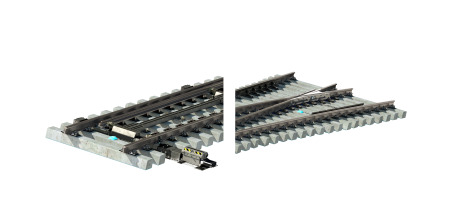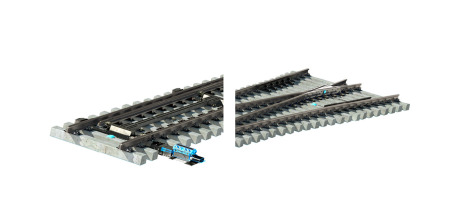Intelligent Turnouts
DIGITAL PERFORMANCE ON TRACK®
The turnout stands as a pivotal asset within the railway system, its malfunctions causing disruptive delays and interruptions. Recognizing the imperative of streamlined railway operations, voestalpine Railway Systems has centered its efforts on optimizing this essential track element using cutting-edge technology.
Discover four compelling reasons why integrating sensors and software to empower switches and crossings is the future:


The intelligent switch machine integrates cutting-edge sensors and tailored algorithms, enabling comprehensive monitoring of the switch machine and its components while diagnosing and predicting potential failures.
At its core lies the measurement and display of movement curves, extracting relevant parameters critical for analysis. This is facilitated through a universally adaptable sensor module, optimized to operate independently on battery power.
Beyond tracking movement curves, it also measures crucial variables like water levels in the housing, oil levels in hydraulic components, and inspection-related factors such as detector rod clearance.
The ultimate goal is to either replace or reduce inspection requirements and extend inspection intervals significantly. This targeted approach aims to enhance the operator's Lifecycle Costs (LCC) by optimizing maintenance schedules.

The switch device monitoring module ensures the safe operation of the switch by continuously overseeing critical rail positions, including the distance between the switch- and stock rails when closed or open, and estimating the proximity of the flangeway.
Should these values exceed predefined safety limits, the switch's safe operation becomes uncertain. Moreover, mechanical parts like the switch- and stock rails might undergo plastic deformation, impacting rail position through laps and burrs. This wear, combined with Rolling Contact Fatigue (RCF), can lead to rail degradation or even component failure, elevating the risk of derailment.
By vigilantly monitoring these damage patterns and faults, this module enhances operational safety for the switch. It extends the lifespan of its components by implementing corrective measures early on, preventing minor defects from escalating into critical breakouts that would necessitate component replacement. This proactive approach not only improves Lifecycle Costs (LCC) but also enhances availability and safety standards.

The vibrations caused by passing trains result in degradation and settling within the ballast layer, leading to alterations in the superstructure's stiffness and increased sleeper movement.
Elevated sleeper displacements, arising from reduced track stiffness or voids within hanging sleepers, significantly amplify dynamic contact forces in turnouts. This, in turn, accelerates mechanical part degradation. Monitoring sleeper displacement and rotation over time facilitates the diagnosis of track (ballast) degradation and predicts critical states to propose necessary actions.
Furthermore, the system can discern operational parameters of passing rolling stock, such as axle distances, train types, speed, and passing route/direction. This data can be utilized for clustering, normalizing acquired data, or capacity monitoring.

The Crossing Area Monitoring module allows for the diagnosis and prediction of wear on critical crossing components like the crossing nose (frog), wing rails, and guard rails. The crossing area's discontinuity subjects mechanical parts in this region to high dynamic impact and creep forces, causing continuous degradation.
A targeted monitoring solution enables condition-based and prescriptive maintenance strategies by assessing the actual health state of assets/components, predicting remaining service life, and suggesting corrective measures well in advance. This proactive approach prevents emerging defects from leading to component failure and subsequent traffic disruptions.
Additionally, this module assesses passing wheel quality to detect worn or hollow wheels, which can elevate dynamic loads and contribute to crossing panel component degradation.

Temperature plays a significant role in track and component behavior. Hence, temperature measurements, augmented with weather service data, form an essential part of monitoring and maintenance recommendations. Algorithms utilize these measurements to determine rail temperatures across various points.
This information aids in planning track maintenance such as tamping and welding and assists in diagnosing and forecasting switch failures.
Enable precise and demand-responsive maintenance actions, minimizing expensive downtimes and optimizing train intervals.
Prolong the lifespan of turnout components and assets, maximizing your investment.
Decrease maintenance expenses while enhancing the availability and profitability of your railway system.
At voestalpine Railway Systems, our Intelligent Turnouts are designed with a modular approach, allowing you to tailor your experience by choosing the information that matters most to you. Here's why our Intelligent Turnout Systems will drive your success:
For unmatched availability and the lowest lifecycle costs, trust voestalpine Railway Systems to deliver Digital Performance on Track®.
Contact us now to discover how our Intelligent Turnout Systems can revolutionize your railway infrastructure!
If you have questions or feedback, please feel free to contact us. We are happy to help!